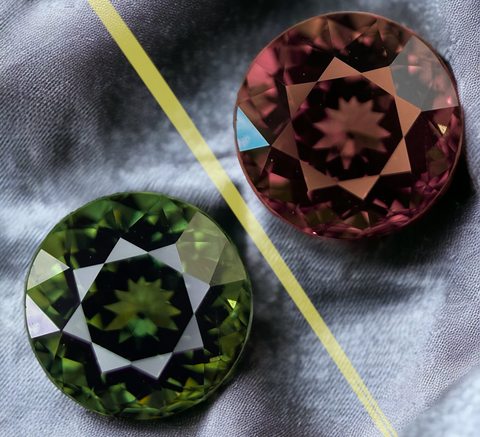Alexandrite
Chrysoberyl
Chrysoberyl is a beryllium-aluminum oxide mineral with a chemical composition of BeAl2O4. It is distinctly different from the beryllium-aluminum silicate (Be3Al2(SiO3)6 mineral known as "beryl," although the similar names can cause confusion. Chrysoberyl is best known for its use as a gem. There are multiple varieties of gem chrysoberyl, each with its own name and unique physical properties.Ordinary chrysoberyl is a yellow to yellow-green to green gemstone with a translucent to transparent diaphaneity. Transparent specimens are usually cut into faceted stones. Specimens that are translucent or with silk are usually cut into cabochons. A photo of ordinary chrysoberyl is shown at the top of this page. The name chrysoberyl comes from the Greek words chrysos, meaning golden, and beryllos, which refers to its beryllium content. Chrysoberyl has been a prized stone for thousands of years in Asia, as it is believed to provide the wearer with protection from the evil eye. There are three different gem varieties of chrysoberyl. Each of these stones is chemically alike, but optically very different, each one having a unique and beautiful feature of its own. The pale yellow green variety of chrysoberyl came from Brazil, and was known as chrysolite. Today however, the most popular varieties of chrysoberyl are cat’s eye and alexandrite. Alexandrite, which is a very durable and rare stone, displays a beautiful color change. In the daylight, it is green, but under incandescent light, it changes to a red, mauve, or brown color. It has been said that alexandrite was named after czar Alexander II, as it was discovered on the czar’s birthday in 1830, in the Ural Mountains.

Alexandrite
“Emerald by day, ruby by night,”

 Although crystals of chrysoberyl are not uncommon, the gemstone variety of Alexandrite, is one of the rarest and most expensive gems. A beryllium aluminum oxide, chrysoberyl is hard and durable, inferior in hardness only to corundum and diamond. It generally occurs in granites or granitic pegmatites. Alexandrite exhibits chatoyancy, the simplest way to explain this optical phenomenon is: a visible white stripe in the center of the gem that makes it appear as a cat’s eye. The largest faceted alexandrite weighs 66 carats. This one-of-a-kind specimen with vibrant green and red hues is on display at the Smithsonian Museum in Washington, DC. It is, undoubtedly, a majestic cushion-cut rock that is originally coming from Sri Lanka. Alexandrite is rarely treated, unlike almost any other member of the gemstone family, alexandrite is a one that is typically untreated. Hence, the reason why it is considered an exceptionally precious possession. However, imitations do exist, but they can be easily identified with the use of special tools and techniques that modern appraisers employ in their work.
Although crystals of chrysoberyl are not uncommon, the gemstone variety of Alexandrite, is one of the rarest and most expensive gems. A beryllium aluminum oxide, chrysoberyl is hard and durable, inferior in hardness only to corundum and diamond. It generally occurs in granites or granitic pegmatites. Alexandrite exhibits chatoyancy, the simplest way to explain this optical phenomenon is: a visible white stripe in the center of the gem that makes it appear as a cat’s eye. The largest faceted alexandrite weighs 66 carats. This one-of-a-kind specimen with vibrant green and red hues is on display at the Smithsonian Museum in Washington, DC. It is, undoubtedly, a majestic cushion-cut rock that is originally coming from Sri Lanka. Alexandrite is rarely treated, unlike almost any other member of the gemstone family, alexandrite is a one that is typically untreated. Hence, the reason why it is considered an exceptionally precious possession. However, imitations do exist, but they can be easily identified with the use of special tools and techniques that modern appraisers employ in their work.
|
Alexandrite |
|
|
Variety of |
Chrysoberyl |
|
Crystallography |
Orthorhombic |
|
Colors |
Varies in color with incident light: green, blue-green, or pale green in daylight; mauve, violet to red, purplish in incandescent light. |
|
Luster |
Vitreous |
|
Hardness |
8.5 |
|
Birthstone |
June |
|
Etymology |
Named after Czar Alexander II of Russia. |
|
Origins |
Ural Mountain, Brazil, Sri Lanka, Burma, Madagascar, Tanzania. |
|
Formula |
BeAl2O4 + Cr |






